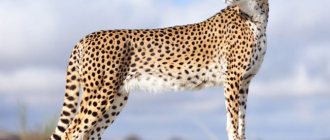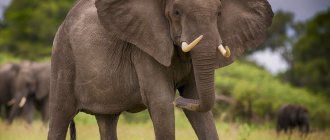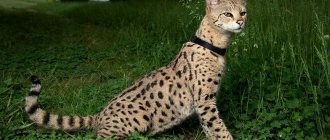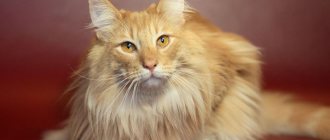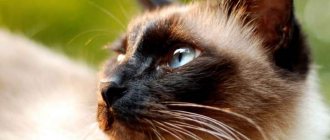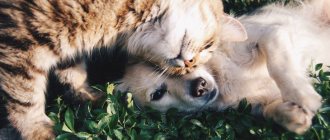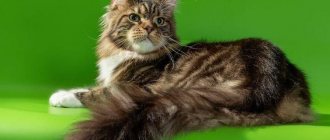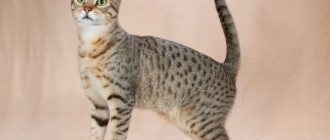- home
- Cats
- Rating of the biggest cats in the world
For those who dream of a pet and want to buy something non-trivial and unusual, the biggest cats are an excellent option. Their habits do not differ from their smaller relatives, but their size amazes the imagination and breaks all stereotypes. Contrary to popular belief, large breeds of domestic cats are very graceful, flexible and elegant. They require more attention, care and care, but compensate for all this with affection and love for the owner. So, here is a list of the largest domestic cats.
For those who dream of a pet and want to buy something non-trivial and unusual, the biggest cats are an excellent option.
Fifth place – Puma
Puma
Other names for puma are mountain lion, cougar, panther. The puma belongs to the genus Puma. Lives in North and South America. Lives in bushes, swamps and forests. Mountain lions are solitary and territorial animals, with ranges ranging from 250 sq. km up to 950 sq. km. The puma has yellow-brown fur, straight ears, and a long tail. The animal is born with spots that disappear as they grow.
Males weigh on average from 50 to 100 kg, females - 30-65 kg . Pumas have large, strong paws and proportionately the largest hind paws in the cat family. This physique helps to jump long distances (4-12 meters) and run fast (60-80 km/h).
The puma does not roar, it makes sounds of hissing, growling, whistling, screaming. Mountain lions are active at dusk, at night, and at dawn; These are predators that eat prey of various sizes - from insects, rodents to medium and large ungulates (especially deer).
The total mountain lion population is estimated to be less than 50,000. The average lifespan in the wild is 8-13 years, in a zoo it is about 20 years.
Chartreuse
The ancestors of the Chartreuse are unknown. But felinologists associate the appearance of the breed with the Crusaders and the Order of the Carthusians. Chartreuses accompanied ships to Africa, saving ship supplies from rodents.
View this post on Instagram
A post shared by Victor Ray (@v1cr4v)
The cat has 2 features. First of all, there is a pronounced hunter’s instinct. Therefore, the animal is not recommended to live together with rodents and birds. Another feature is long-term growth. The pet grows up to 5 years. The height of an adult Chartreux is 30 cm, weight is 7–9 kg for a male and 4–5 kg for a female.
Fourth place – Leopard (Panthera pardus)
Leopard
The fourth largest among wild cats is the leopard. There are 9 subspecies of leopard (African, Indian, Javan, Arabian, Anatolian, Amur, Indochinese, Sri Lankan), which are found in Africa, East and South Asia. These cats live in tropical forests, deserts, savannas, grasslands, mountains, coastal areas, scrub and swampy areas.
Interesting: The most dangerous frogs - list, description, photos and videos
Leopards spend a lot of time in trees and are active mainly at night. Leopards have a muscular, flexible body, they run at a speed of 60 km/h, and jump 6 meters in length and 3 in height. Like pumas, leopards are solitary, territorial, predatory animals. Leopards roar, growl, meow. Their roar is associated with the spraying of wood.
Leopard fur color ranges from pale yellow to tan or gold. There are dark spots on the body, which are called “rosettes” because they are shaped like a rose. Males are larger and heavier than females: 40-90 kg versus 30-60 kg .
Leopards are endangered. The rarest subspecies, the Amur leopard, is found in the Far East, Korea and northeast China, with only 30 individuals in the wild. The average lifespan is 12-17 years in the wild and up to 23 years in zoos.
Housey (chausie)
The third place in the top is occupied by the hydrid of the jungle cat and the domestic cat – chausie. The length of the wild ancestor is 60–90 cm, weight is 8–12 kg. Special features: short tail and tufted ears. Chausie weight is 14–16 kg. Height at withers – 40 cm.
View this post on Instagram
A post shared by Victor Ray (@v1cr4v)
The breed owes its popularity to tourists visiting Egypt. Travelers noticed the soft sandy color, regal manners and hunting skills of the furry resident of this eastern country. The stories of tourists interested the breeders. As a result, in 1960 the first American-bred Chausies appeared.
Third place – Jaguar (Panthera onca)
Jaguar
The Jaguar is the largest cat in the Americas and the third largest in the world. The preferred habitats of jaguars are swamps and wooded areas; but they also live in bushes and deserts. The largest population of jaguar is in the Amazon rainforest. Jaguars roar, they have a powerful jaw, sharp and strong fangs, which gives a high bite force. The coat is usually yellow-brown, but the color sometimes varies from reddish-brown to black. Black jaguars, leopards and pumas that exhibit melanism are called "black panthers" or simply "panthers".
How to distinguish a jaguar from a leopard?
How to distinguish a jaguar from a leopard
The jaguar has dark “rosette” spots on its body, in the center of which, unlike the leopard, there are black dots. Along the midline of the back there is a row of long black spots that sometimes merge into stripes.
The male jaguar is larger than the female and weighs between 100 and 160 kg. They establish territories twice as large as females and cross the ranges of several females.
Jaguars are endangered. There are an estimated 15,000 jaguars left in the wild. Life expectancy is 12-15 years, in the zoo over 20 years.
Siberian
Cats bred in Russia. They especially stand out among their relatives for their size.
Males can weigh twelve kilograms, but females weigh less, only five or six.
Their main feature is their excessive fluffiness and docile nature. They look like large and overwhelming bundles of tenderness. Felinologists say that Siberian cats are hypoallergenic, so even very sensitive people can have them. A Siberian cat can be purchased from 5,000 rubles. up to 20,000 rub.
Second place – Lion (Panthera leo)
Lion
Known for his majesty, strength, beauty and nicknamed the "king of the jungle", the lion is the second largest cat in the world . Lions live in grassy plains, savannas, open forests and bushes. The size and appearance of lions differ between the sexes: males weigh 150-250 kg, females 110-180 kg . Males have a mane that protects the neck and throat in fights with rivals. Lions have tufts of six at the end of their tail. Coat color ranges from light yellow to silvery white and yellowish red to dark brown. Lion cubs are born with dark spots on their bodies that disappear as they mature.
Interesting: The smallest countries - list, area, where they are located, photos and videos
Historically, lions lived in most of Europe, Asia and Africa, but are now found in only two regions of the world and are divided into two subspecies:
- Asiatic lions that live in the Gir Forest National Park in India. This population numbers fewer than 500 lions;
- African lions live in Africa south of the Sahara Desert. There are fewer than 21,000 lions left in Africa.
Lions are active at night when hunting. Their speed reaches 80 km/h, and their jump is up to 11 meters. They hunt for 2-3 hours, resting the rest of the time. Lions have the loudest roar of any big cat, which can be heard up to 8 km away .
The lion is the most social wild cat. Lions live in groups called "prides" of about 15 animals. Each group has a territory that they defend from other predators. Its area is 20-400 sq. km. Lionesses often go out hunting together. Lions live on average 10-14 years in the wild and longer than 20 years in zoos.
Savannah
The breed was obtained by crossing a Bengal cat with an African Serval. The serval weighs 8–18 kg, reaches 65 cm at the withers. The length of the body with tail is 90–135 cm. Savannah was registered in 2001. The height of the miniature relative of the cheetah at the withers reaches 60 cm. Weight is 15–18 kg.
View this post on Instagram
A post shared by Victor Ray (@v1cr4v)
In 2007, a new breed of Asher was introduced to the public. Upon careful analysis, it turned out that the cat belonged to the Savannah breed. Although some sources still believe that the Asher is a separate breed.
The biggest cat in the world
Tiger
The largest cat in the world is the tiger. Tigers have orange fur with distinctive black vertical stripes that help camouflage when hunting prey; There are black and white tigers with golden stripes, as well as white (albinos). The stripes on the body of tigers are individual, like human fingerprints.
Tigers live in South Asia, China and the Far East. The habitat includes a variety of places ranging from dry grasslands to tropical forests. Tigers are skilled swimmers who swim across lakes and rivers with a width of 6-8 km.
Interesting: Panthers - description, where they live, food, reproduction, enemies, photos and videos
Tigers weigh from 65 to 325 kg, the largest of them - Siberian, also called Amur - weigh about 300 kg . The Bengal tiger makes up about half the tiger population.
There are 9 recognized tiger subspecies: Bengal, Siberian (Amur), Indochinese, South China, Sumantra, Malayan, Caspian, Javan and Balinese. The last 3 subspecies have become extinct over the last century, the South China tiger is extinct in the wild, the remaining subspecies are classified as endangered by the International Union for Conservation of Nature as their numbers are declining due to habitat loss and poaching. Since the beginning of the 20th century, tiger numbers have declined from 100,000 to 3,200.
Tigers are solitary predatory animals: they spend a lot of time alone, traveling through their territories in search of food. The Siberian tiger has the largest range - up to 10,000 square meters. km. Tigers' food consists mainly of large prey (deer, wild pigs, rhinoceroses, antelope, buffalo, elephants). The average lifespan of a tiger in the wild is between 14 and 18 years.
Irbis (snow leopard)
Snow leopards are well adapted to life in the snow. (Image credit: Jeff Wendorf/Getty Images)
According to the Snow Leopard Foundation, a nonprofit conservation organization dedicated to protecting snow leopards, snow leopards (Panthera uncia) are an elusive cat native to the mountains of Central Asia, including Afghanistan and China. Like the clouded leopard, the snow leopard, also called the snow leopard, has the word "leopard" in its name, but is not a leopard, which is a separate species. However, snow leopards are in the same genus Panthera as leopards and other big cats such as lions (Panthera leo) because they are closely related. Snow leopards grow up to 1.3 meters in length from head to rump, but their tails can add another 1 meter to their total body length. They can weigh up to 54 kg. ()
Snow leopards prefer to hunt wild sheep such as blue sheep and other cliff-dwelling species. However, human activity has reduced their habitat and prey, so the big cats sometimes take livestock such as goats. This brings the cats into conflict with local herders, who depend on their livestock and kill the snow leopards in retaliation.
Liger
Liger
There is a cat even bigger than the tiger. This is a "liger" - a giant lion with blurry stripes, resulting from crossing a tiger with a lioness. Scientists believe that the size of the hybrid is the result of the absence of genes that limit growth. Ligers grow to a length of more than 3.5 meters and weigh more than 400 kg . There are about 25 ligers on the planet. The behavioral traits of this animal appear as a combination of the habits of both parent species.
Thus, fifth place in the list of the TOP 5 largest cats in the world is occupied by the puma, which is a member of the genus Puma. The highest positions are occupied by cats that belong to the genus Panthera - leopard, jaguar, lion and tiger, which tops this ranking. The cat, even larger in size than a tiger, is a liger - a hybrid obtained by crossing a lion and a tigress.
If you find an error, please select a piece of text and press Ctrl+Enter.
Ragdoll
This is a breed obtained through selection in the 20th century. Breeder: Ann Baker from California, USA. The breed was registered in 2000. Known for her flexible character.
View this post on Instagram
A post shared by Victor Ray (@v1cr4v)
The name comes from the habit of relaxing. The pet purring in your arms sags, resembling a rag doll. It is believed that the observed flexibility of the cat is associated with a genetic disorder. Height at withers – 30–40 cm. Weight – 7–12 kg.
British Shorthair
This breed of cats reaches 7-8 kg, have a friendly character, although it is believed that the British are arrogant, independent and “walking on their own” cats.
They have high intelligence, playfulness, and, of course, independence; they will not tolerate bad treatment. The average price of a British shorthair cat is about 12,000 rubles.
Features of keeping giant cats
Large pets require special conditions. They need more food and exercise. Otherwise, their health may suffer.
Feeding
Avoid two things: overfeeding and mono-feeding. Animals reach their maximum weight only by 3-4 years, so there is no need to contribute to its gain ahead of time. In this case, instead of a muscular and graceful cat, you will have a bun that moves with difficulty.
When calculating daily caloric intake, be guided by the average recommendations, but be sure to adjust them to suit your pet through observations. The higher the activity, the more food is required. An insufficient amount of food can be easily tracked by weight loss, so do not forget about periodic weighing.
Don't feed your cat only meat. Animal proteins are healthy and nutritious, but such a diet may result in a deficiency of calcium and other important elements. In addition to them, the diet should contain:
- fats (sea fish, flaxseed);
- carbohydrates (zucchini, apples, oatmeal);
- sprouted oats and brewer's yeast.
On a natural basis, it is recommended to add vitamins to food. They are selected by a veterinarian based on tests.
Large animals often suffer from diseases of the musculoskeletal system. If your pet eats dry food, take him food with chondroprotectors that improve the functionality of the joints.
Predisposition to disease
Heavy weight puts a lot of stress on bones and joints, so first of all you should be wary of arthritis and dysplasia. In addition to proper nutrition, prevention includes mandatory observation by a veterinarian. A predisposition to joint pathologies is usually inherited, so be sure to check information about the kitten’s parents before purchasing it.
All other ailments depend not on the size of the cat, but on its breed. Maine Coons are prone to diseases of the urinary system, Siberians - to food allergies, Ragdolls - to cardiovascular diseases, and Chausies - to digestive disorders.
If you decide to purchase a purebred pet, study detailed information about the features of its maintenance and care. This will allow you to adequately assess the risks and compare them with your capabilities.
Do you like the article? 0
Forest Norwegian
In our area, Scandinavian forest cats are rare; the breed is common in the countries of Northern Europe. The weight of the animal reaches 10 kg. It is considered the national breed of Norway. Cats have a quiet, good character, are very sociable, and quickly become attached to a person.
The price of a kitten starts from 10,000 rubles; for trained exhibition participants you will sometimes have to pay 30,000 or 40,000 rubles.
Interesting records
Sometimes among the record holders there were very funny cats. For example, the heaviest cat was the representative of the title “The plumpest domestic cat” with the funny name SpongeBob. He weighed about 15 kg, but now he had to go on a diet.
He was the last cat to take first place in this category, because they decided to exclude the category itself, so that lovers of fame, their owners, would not torture their poor animals. After all, there have been cases when the owners of a cat achieved its victory by sacrificing the life of their pet. This is exactly what happened to the cat Khiimiya from Austria, who was able to gain weight of 21 kilograms. Unfortunately, it was obesity that killed him.
You need to take care of your pets, do not forget about their health, give them love and care, then you will become the owner of the happiest cat in the world.
Eurasian lynx
Of all the cats that inhabit European forests, the largest is the common lynx. The body weight of a male is about 29 kg, females are 4-6 kg lighter. The body length does not exceed 130 cm. Mammals live in Russia, Central Asia, Central and Northern Europe. At the beginning of the 20th century, the extermination of predators led to the threat of their extinction. Today, lynx fishing is prohibited everywhere.
The animal with tasseled ears and a short tail seems cute and harmless. But under the spotted thick coat hides a skillful and cunning hunter, capable of smelling prey at a distance of 2 km. Its victims include hares, foxes, birds, rodents and small ungulates: roe deer and musk deer. Lynx never attacks people. Even an adult caught by a person is easily tamed and becomes a pet.

